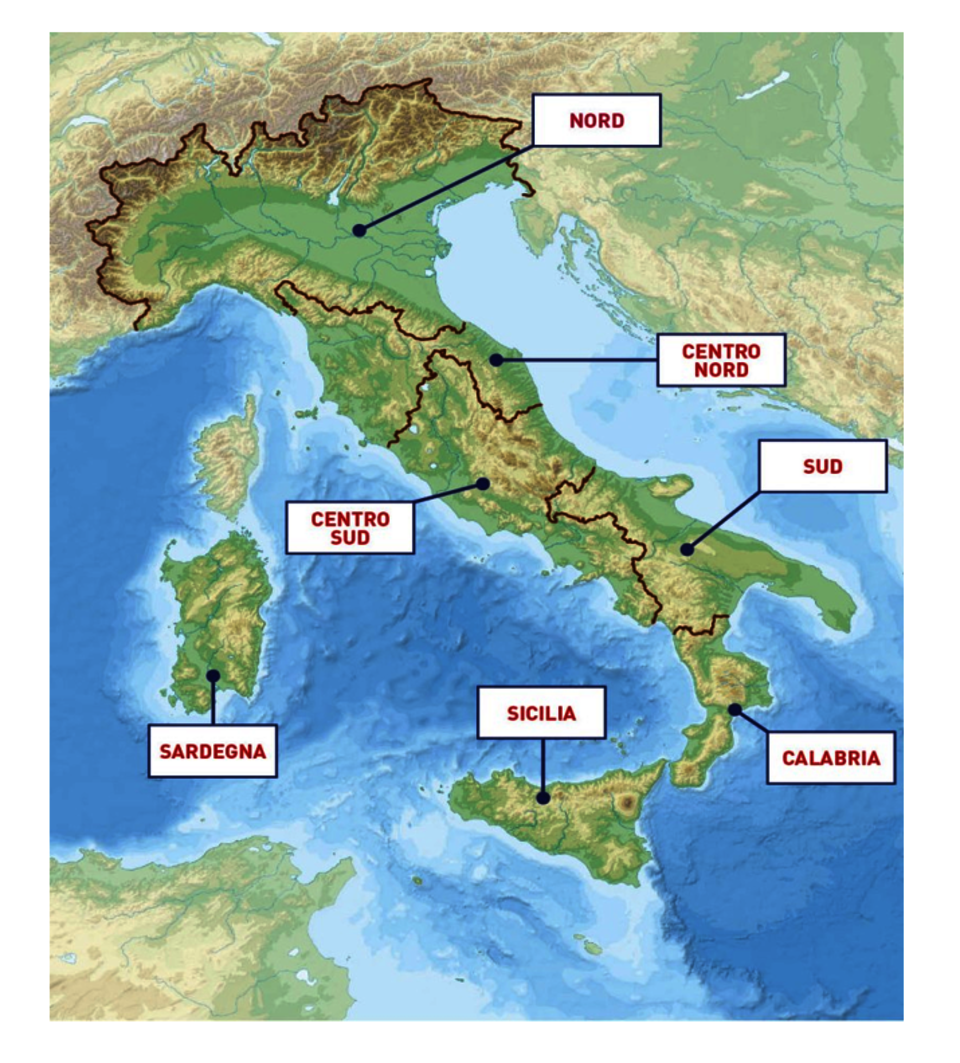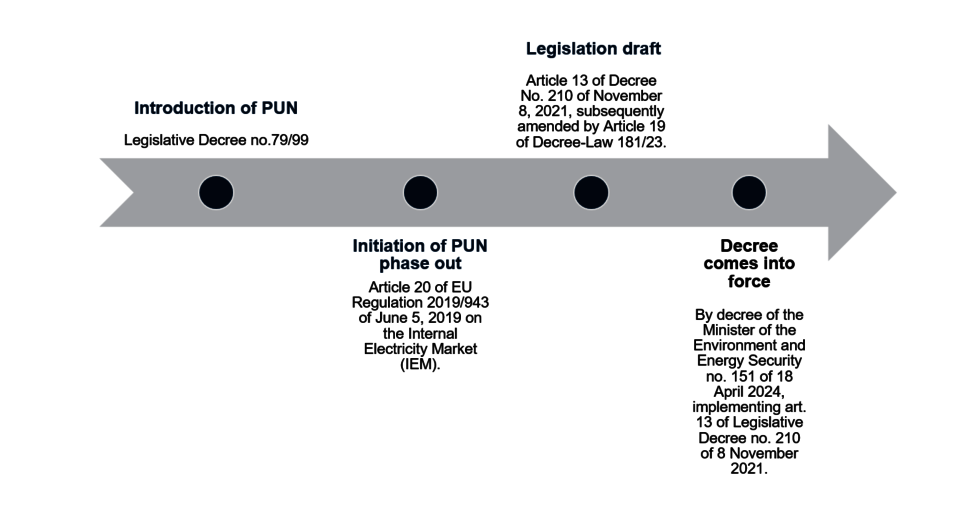Italy to phase out PUN in 2025

By Nermin Hadžić, Policy Analyst, and Edin Fazlović, Senior Operations Analyst
Italy is unique among European countries in its approach to the Day-Ahead Market (DAM), where buyers pay a standardized purchase price for electricity, known as the Prezzo Unico Nazionale (PUN), regardless of their geographic location. However, sellers’ offers are based on zonal prices specific to their regions. This system ensures that consumers across Italy face the same electricity costs, irrespective of their location.
The PUN was introduced when the Italian electricity market was established. Its purpose is to address regional price disparities for consumers, thereby promoting uniform electricity costs nationwide. The aim is to reduce the impact of uneven distribution of power generation facilities across Italy, which differ in efficiency and are influenced by the limited capacity of the national grid to transfer electricity between lower-priced and higher-priced zones.
The zonal prices will divide the country into seven electricity market regions and establish specific prices for each of them. Consequently, consumers in different regions may experience variations in electricity costs (Picture 1).

Regulatory background

The liberalization of Italy's energy sector, initiated by Legislative Decree No. 79/99, led to the establishment of the Italian Power Exchange (IPEX). This platform enables both Italian and foreign producers to sell energy wholesale to suppliers serving end users.
In alignment with the European Commission's directive for greater integration of the European internal market, Italy has been instructed to phase out the Single National Price (PUN) by 2025, as outlined in Article 20 of Regulation 2019/943 of June 5, 2019, on the Internal Electricity Market (IEM). Consequently, starting in 2025, only zonal prices (PUN GME) will be in place in Italy's DAM.
In response to this mandate, the Ministry of the Environment and Energy Security (MASE) addressed these changes in Article 13 of Decree no. 210 of November 8, 2021, further amended by Article 19 of Decree-Law 181/23.
Subsequently, Ministerial Decree no. 151 of April 18, 2024, implementing Article 13 of Legislative Decree no. 210 of November 8, 2021, established the conditions and criteria for applying zonal prices to end customers, effective from January 1, 2025, based on the dynamics of the wholesale electricity market.
Pricing methodology
The PUN serves as the uniform purchase price for all energy buyers, including traders and large consumers who access the DAM, irrespective of their market zone of origin. While sellers operate under a zonal pricing system, which is determined by the specific market zone where they submit their sales offers, buyers uniformly encounter the PUN across all zones. This price is calculated as the weighted average of zonal prices in the DAM, based on the total purchase volumes subject to the PUN.
As part of the transition to zonal pricing, the introduction of a zonal PUN mechanism is under discussion, managed through a transitional equalization process. This mechanism is designed to compensate for any difference between zonal prices and the reference price established by the Italian Energy Market Operator (GME).
In its recent consultation document, DCO 94/2024/R/EE, the Italian Regulatory Authority for Energy, Networks and Environment (ARERA) expressed support for applying an equalization component to purchases in the day-ahead market, functioning as follows:
(a) If the PUN Index GME is €100/MWh and the zonal price is €80/MWh, the unit equalization component, equal to the difference between the PUN Index GME and the zonal price, would be +€20/MWh. It would be charged to all accepted purchase bids in that zone. Therefore, the market operator would pay a total of €100/MWh (€80/MWh for the zonal price and €20/MWh for the equalization component).
(b) If the PUN Index GME is €100/MWh and the zonal price is €120/MWh, the unit equalization component, equal to the difference between the PUN Index GME and the zonal price, would be -€20/MWh. It would be credited to all accepted purchase bids in that zone. Therefore, the market operator would pay a total of €100/MWh (€120/MWh for the zonal price and -€20/MWh for the equalization component).
This approach would allow the regulatory framework to remain unchanged - apart from the use of the PUN Index GME in place of the PUN - without disrupting the balance of financial transactions between market operators and GME. This would enable the PUN Index GME to continue to serve as the natural reference for wholesale purchases, simplifying the impact on retail free market contracts indexed to the PUN, where the PUN could simply be replaced by the PUN Index GME.
The other hypothesis, involving the application of an equalization component to the energy withdrawn, appears much more complex and impactful at all levels, with the need to separately highlight the zonal price and the new equalization component in retail contracts.
The gradual phaseout of the equalization mechanism, as per the Decree of April 18, 2024, can only begin in 2026 with at least 12 months' notice.
Expected impacts of zonal tariffs
Zonal tariffs will not only offer fairer pricing, better reflecting the real costs of production and distribution, but will also incentivize investment in renewable energy. With potentially lower prices in areas of high renewable generation, areas with a strong presence of solar and wind energy could benefit from more competitive tariffs, thus pushing towards an increase in the installed capacity of renewable sources and a reduction in fossil fuel dependence.
Impacts from the introduction of zonal tariffs will vary region to region. Areas such as Sicily and Calabria, which are traditionally more dependent on expensive or less efficient energy sources, could experience an increase in tariffs compared to the PUN system. Conversely, areas in Northern Italy, which are rapidly moving towards the adoption of renewable technologies, could see a reduction in energy costs. This zonal variation aims to balance existing disparities and promote the fair distribution of energy resources.
The termination of the PUN and the adoption of zonal tariffs represent a significant turning point for the Italian energy market. This reform is set to profoundly influence the way energy is priced and consumed in Italy, promoting a more sustainable use of resources and greater attention to territorial specificities. This could lead to an increase in investment in renewable technologies and greater consumer awareness of the origin and cost of the energy they use.
